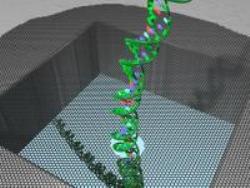Oxford Nanopore Technologies has signed a contract with the Office of Technology Development at Harvard University to design a graphene that will be used for DNA sequencing. The grapheme characteristics render it suitable for high resolution, sequencing based on nanopores of individual DNA atoms.
 ON's Graphene
ON's Graphene
According to the contract, Oxford Nanopore will have special rights to design and retail systems, which will utilize graphene to probe DNA and RNA that will be produced in the Harvard laboratories run by Professors Jene Golovchenko, Daniel Branton, and Charles Lieber. The contract is an extension of an earlier agreement between the two entities stipulating designing of systems to deploy nanopore sensors and solid-state nanopores. Oxford Nanopore will support basic nanopore research at the university.
Graphene is emerging as a wonder material for the 21st century and he said that recent research has shown that it has transformative potential in DNA sequencing. said Dr Gordon Sanghera, CEO of Oxford Nanopore Technologies. He also added that the groundbreaking research at Harvard lays the foundation for the development of a novel solid-state DNA sequencing device And that they are proud to partner with the research team that pioneered early nanopore discoveries and that which, continues to break boundaries with new materials and techniques.
According to a publication in Nature in 2010, Harvard researchers used the substance to split two compartments containing ionic fluids to develop a cavity or nanopore. The group discovered that the nanopore could work as a trans-electrode to determine a current passing through the nanopore. The trans-electrode determined current changes while an individual DNA atom moved through the nanopore. This caused an electrical signal that reflected the size and conformation of the DNA molecule.
This technology will enhance the cost, energy and characteristics of DNA sequencing. Oxford Nanopore will utilize artificial solid substances like silicon nitride.
Source: http://nanoporetech.com/